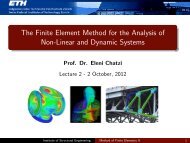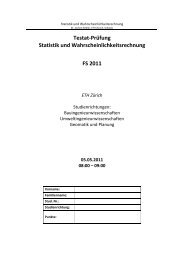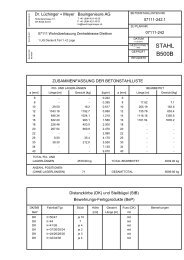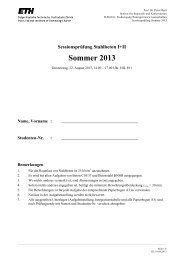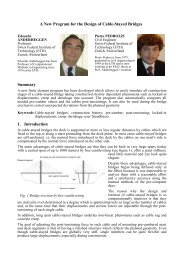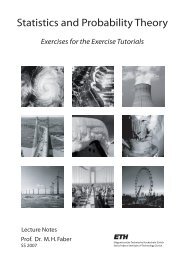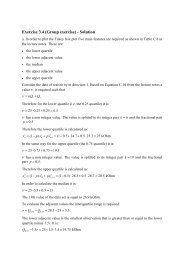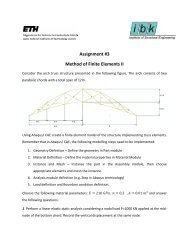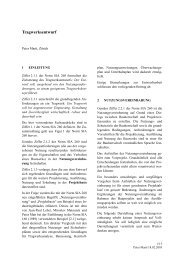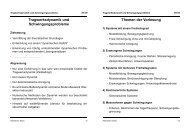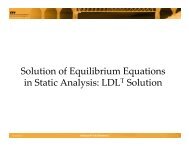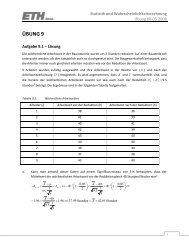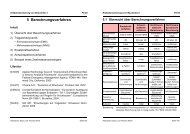The Finite Element Method for the Analysis of Non-Linear and ...
The Finite Element Method for the Analysis of Non-Linear and ...
The Finite Element Method for the Analysis of Non-Linear and ...
You also want an ePaper? Increase the reach of your titles
YUMPU automatically turns print PDFs into web optimized ePapers that Google loves.
Truss <strong>and</strong> Cable <strong>Element</strong>s - Example<br />
<strong>The</strong>n equation (10) can be rewritten as:<br />
[ t<br />
]<br />
τ 0<br />
R<br />
R<br />
0 0<br />
T t ρ<br />
=<br />
0 ρ RU t 0 S RUT ⇒ R<br />
[ t<br />
]<br />
τ 0<br />
t [<br />
ρ<br />
t0<br />
=<br />
0 0 0 ρ U t 0 S S 0<br />
UT ⇒<br />
0 0<br />
[ t τ 0<br />
0 0<br />
]<br />
=<br />
]<br />
R T t ρ<br />
=<br />
0 ρ RU t 0 S UT R T ⇒<br />
0 ρ<br />
t ρ U−1 [ t τ 0<br />
0 0<br />
]<br />
(U −1 ) T<br />
Ultimately, carrying out <strong>the</strong> calculations yields:<br />
t<br />
0 0 S 11 = ρ 0<br />
t ρ ( L t P<br />
0 L + ∆L )2 t A<br />
Since mass=const<br />
0 ρ 0 L 0 A = t ρ 0 L + ∆L t A ⇒ t 0 0 S 11 = L t P<br />
0 L + ∆L 0 A<br />
Note how <strong>the</strong> components <strong>of</strong> t 0S do not depend on rotation, hence <strong>the</strong> tensor retains only<br />
<strong>the</strong> S 11 one component. <strong>The</strong>n, <strong>the</strong> nonlinear part <strong>of</strong> <strong>the</strong> stiffness matrix is derived as:<br />
∫<br />
t<br />
0 K t T<br />
NL = 0 B NL 0 S t 0 B NLd 0 V<br />
0 V<br />
[<br />
where t 0 B NL = ( 0 J −1 −1 0 1 0<br />
) N ,ξ =<br />
0 −1 0 1<br />
]<br />
Institute <strong>of</strong> Structural Engineering <strong>Method</strong> <strong>of</strong> <strong>Finite</strong> <strong>Element</strong>s II 24



